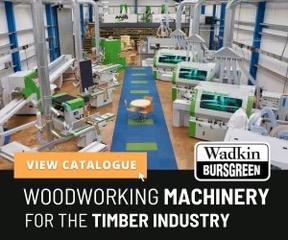A CNC router is one of the most versatile and flexible production tools available to industries as diverse as signage, industrial woodworking, furniture manufacturing, panel processing and plastics and metal fabrication, to name only a few.
A CNC router can invariably offer a faster ROI by comparison with any other type of production machinery and will enable further diversification into other industrial sectors without the need to purchase expensive additional equipment.
Understanding the technology available, the decisions that need to be made prior to the purchase of a CNC router, the operator training necessary and the different tools and settings available are critical to maximisation of the potential that exists for fuelling business growth and increasing profitability. Application engineer at AXYZ International in the UK, Ged Lodge provides some useful guidelines to help CNC router owners understand all of these influencing factors.
1) Make sure machine settings are correct
This commences with use of the correct feed rates, router spindle speeds and the depth of cut specific to the material being processed, all of which should be available from the supplier of the machine.
These settings are interrelated. For example, cutting at a higher feed rate may require a faster spindle or a reduction in the depth of cut. Tool selection and the type of processing program employed will also have an effect.
Again as an example, a small-diameter router tool will normally be run at a lower feed rate than that of a larger-diameter tool. This is one of the areas where expertise gained over time will make it easier for operators of CNC routers to sense when there is a potential machinery malfunction, with the noise of the router when cutting providing a good indicator of whether or not the settings are correct.
2) Selecting the right routing/ cutting tool
This will relate directly to the type of material being processed. For example, operators should consider if the material could be more effectively processed using a traditional router spindle and if so in what size or, for more malleable materials, would an oscillating or tangential knife be the better option.
When processing new and possibly unfamiliar materials, it is advisable to run some preliminary tests involving different spindles or knife blades to establish which of the two works best for a given application. Again, the machine supplier can help or the information will be available via the router/cutter guides supplied.
3) Use the right material hold-down system
Invariably this will be vacuum-based which better ensures the material is held firmly in place to avoid an incorrect cutting depth and tolerances not maintained, which will lead to costly scrapping of the material being processed. Furthermore, insufficient vacuum strength due to leakage in the system could lead to shifting of the material that is barely noticeable until the job is complete and either deemed satisfactorily routed/cut or rejected because it is not.
Always ensure that the surface of the material is smooth and flat and free of dust and check for any leakages in the vacuum pipes or gaskets. Warped sheet, for example, is more difficult to hold down securely on the vacuum deck.
4) Provide machine operators with the appropriate training
Experienced and well-trained machine operators will be able to narrow down issues that may arise on the shop floor. They will be able to identify root causes of any problems, from the data programmed to the type of tool used and the routing/cutting speeds and feed rates required.
Today’s CNC routers are designed to be intrinsically user-friendly and to make problem-solving so much easier than hitherto. However, in common with any other form of machinery, the more experienced the machine operator the easier it will be to identify and correct any problems. Most of the leading suppliers can provide application-specific training.
5) Develop a program strategy and incorporate quality data
Quality of the data installed is the first consideration. If CAD/CAM data is of a sub-standard, the finished routed/cut product will be correspondingly so. Make sure the cut lines of a job are straight and the curves smooth.
Program strategy is equally important. The positioning of the ‘start’ points, cut direction and the order in which parts are processed can make a huge difference to the quality of the end-product. It is important to master programming techniques such as holding tabs, lead-ins and ramps and where and how these may be used to improve routing/cutting efficiency and avoid problems caused by material movement or machine vibration.
In conclusion
Due to its wide-ranging capabilities, a CNC router can rout/cut virtually any material cleanly and efficiently using a variety of routing/cutting tools. This means all work undertaken can be completed in-house, without the need for outsourcing and the variables that can then arise in terms of finished quality and delays that will erode profit margins.
It is important to fully understand a CNC router’s capabilities and how it should be managed properly. Learning to use a router does not take long – invariably two to three days – although application-specific knowledge will be gained over a longer period and involves a continuous learning curve.
01952 291600
www.axyz.co.uk








